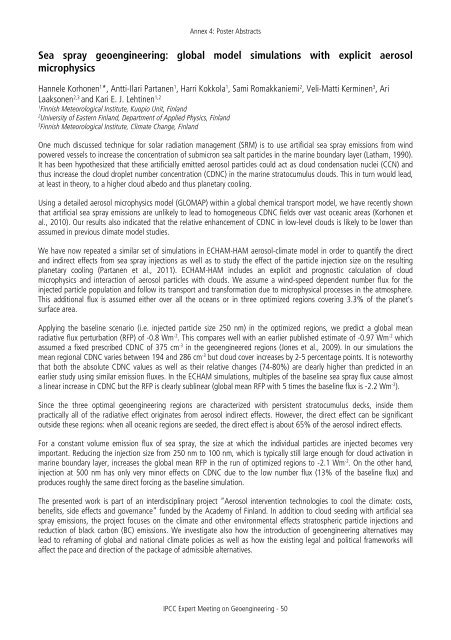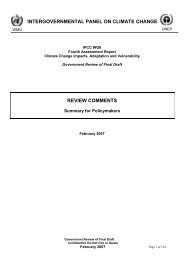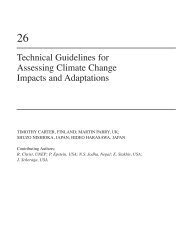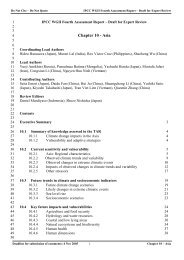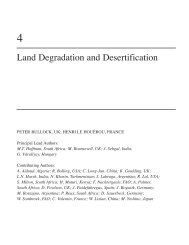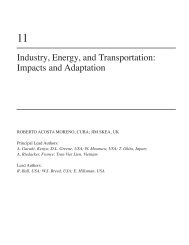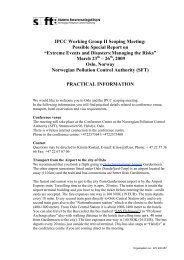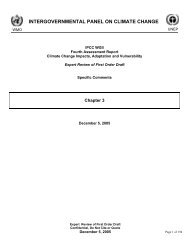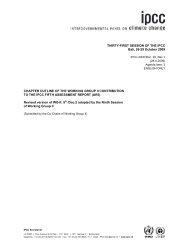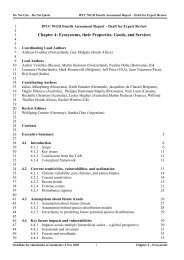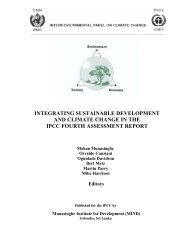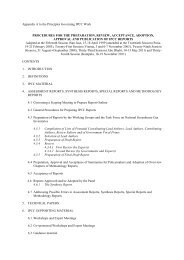IPCC Expert Meeting on Geoengineering
IPCC Expert Meeting on Geoengineering
IPCC Expert Meeting on Geoengineering
Create successful ePaper yourself
Turn your PDF publications into a flip-book with our unique Google optimized e-Paper software.
Annex 4: Poster Abstracts<br />
Sea spray geoengineering: global model simulati<strong>on</strong>s with explicit aerosol<br />
microphysics<br />
Hannele Korh<strong>on</strong>en 1 *, Antti-Ilari Partanen 1 , Harri Kokkola 1 , Sami Romakkaniemi 2 , Veli-Matti Kerminen 3 , Ari<br />
Laaks<strong>on</strong>en 2,3 and Kari E. J. Lehtinen 1,2<br />
1<br />
Finnish Meteorological Institute, Kuopio Unit, Finland<br />
2<br />
University of Eastern Finland, Department of Applied Physics, Finland<br />
3<br />
Finnish Meteorological Institute, Climate Change, Finland<br />
One much discussed technique for solar radiati<strong>on</strong> management (SRM) is to use artificial sea spray emissi<strong>on</strong>s from wind<br />
powered vessels to increase the c<strong>on</strong>centrati<strong>on</strong> of submicr<strong>on</strong> sea salt particles in the marine boundary layer (Latham, 1990).<br />
It has been hypothesized that these artificially emitted aerosol particles could act as cloud c<strong>on</strong>densati<strong>on</strong> nuclei (CCN) and<br />
thus increase the cloud droplet number c<strong>on</strong>centrati<strong>on</strong> (CDNC) in the marine stratocumulus clouds. This in turn would lead,<br />
at least in theory, to a higher cloud albedo and thus planetary cooling.<br />
Using a detailed aerosol microphysics model (GLOMAP) within a global chemical transport model, we have recently shown<br />
that artificial sea spray emissi<strong>on</strong>s are unlikely to lead to homogeneous CDNC fields over vast oceanic areas (Korh<strong>on</strong>en et<br />
al., 2010). Our results also indicated that the relative enhancement of CDNC in low-level clouds is likely to be lower than<br />
assumed in previous climate model studies.<br />
We have now repeated a similar set of simulati<strong>on</strong>s in ECHAM-HAM aerosol-climate model in order to quantify the direct<br />
and indirect effects from sea spray injecti<strong>on</strong>s as well as to study the effect of the particle injecti<strong>on</strong> size <strong>on</strong> the resulting<br />
planetary cooling (Partanen et al., 2011). ECHAM-HAM includes an explicit and prognostic calculati<strong>on</strong> of cloud<br />
microphysics and interacti<strong>on</strong> of aerosol particles with clouds. We assume a wind-speed dependent number flux for the<br />
injected particle populati<strong>on</strong> and follow its transport and transformati<strong>on</strong> due to microphysical processes in the atmosphere.<br />
This additi<strong>on</strong>al flux is assumed either over all the oceans or in three optimized regi<strong>on</strong>s covering 3.3% of the planet’s<br />
surface area.<br />
Applying the baseline scenario (i.e. injected particle size 250 nm) in the optimized regi<strong>on</strong>s, we predict a global mean<br />
radiative flux perturbati<strong>on</strong> (RFP) of -0.8 Wm -2 . This compares well with an earlier published estimate of -0.97 Wm -2 which<br />
assumed a fixed prescribed CDNC of 375 cm -3 in the geoengineered regi<strong>on</strong>s (J<strong>on</strong>es et al., 2009). In our simulati<strong>on</strong>s the<br />
mean regi<strong>on</strong>al CDNC varies between 194 and 286 cm -3 but cloud cover increases by 2-5 percentage points. It is noteworthy<br />
that both the absolute CDNC values as well as their relative changes (74-80%) are clearly higher than predicted in an<br />
earlier study using similar emissi<strong>on</strong> fluxes. In the ECHAM simulati<strong>on</strong>s, multiples of the baseline sea spray flux cause almost<br />
a linear increase in CDNC but the RFP is clearly sublinear (global mean RFP with 5 times the baseline flux is -2.2 Wm -2 ).<br />
Since the three optimal geoengineering regi<strong>on</strong>s are characterized with persistent stratocumulus decks, inside them<br />
practically all of the radiative effect originates from aerosol indirect effects. However, the direct effect can be significant<br />
outside these regi<strong>on</strong>s: when all oceanic regi<strong>on</strong>s are seeded, the direct effect is about 65% of the aerosol indirect effects.<br />
For a c<strong>on</strong>stant volume emissi<strong>on</strong> flux of sea spray, the size at which the individual particles are injected becomes very<br />
important. Reducing the injecti<strong>on</strong> size from 250 nm to 100 nm, which is typically still large enough for cloud activati<strong>on</strong> in<br />
marine boundary layer, increases the global mean RFP in the run of optimized regi<strong>on</strong>s to -2.1 Wm -2 . On the other hand,<br />
injecti<strong>on</strong> at 500 nm has <strong>on</strong>ly very minor effects <strong>on</strong> CDNC due to the low number flux (13% of the baseline flux) and<br />
produces roughly the same direct forcing as the baseline simulati<strong>on</strong>.<br />
The presented work is part of an interdisciplinary project “Aerosol interventi<strong>on</strong> technologies to cool the climate: costs,<br />
benefits, side effects and governance” funded by the Academy of Finland. In additi<strong>on</strong> to cloud seeding with artificial sea<br />
spray emissi<strong>on</strong>s, the project focuses <strong>on</strong> the climate and other envir<strong>on</strong>mental effects stratospheric particle injecti<strong>on</strong>s and<br />
reducti<strong>on</strong> of black carb<strong>on</strong> (BC) emissi<strong>on</strong>s. We investigate also how the introducti<strong>on</strong> of geoengineering alternatives may<br />
lead to reframing of global and nati<strong>on</strong>al climate policies as well as how the existing legal and political frameworks will<br />
affect the pace and directi<strong>on</strong> of the package of admissible alternatives.<br />
<str<strong>on</strong>g>IPCC</str<strong>on</strong>g> <str<strong>on</strong>g>Expert</str<strong>on</strong>g> <str<strong>on</strong>g>Meeting</str<strong>on</strong>g> <strong>on</strong> <strong>Geoengineering</strong> - 50


